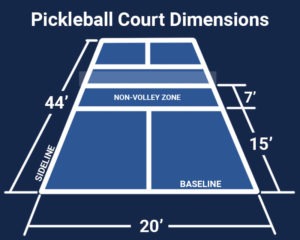Pickleball Court Construction Price Guide-- What to Expect
Pickleball Court Construction Price Guide-- What to Expect
Blog Article
Lasting Practices in Pickleball Court Building And Construction You Must Know
As the popularity of pickleball remains to rise, so as well does the need for sustainable methods in court building and construction. This technique not only addresses ecological worries but also improves the durability and performance of the courts. From selecting environment-friendly products to implementing reliable drain and energy-saving lights options, there are numerous techniques to take into consideration. Yet, the impact of these practices extends far beyond the court itself. Comprehending how each component adds to a much more sustainable future welcomes even more expedition into the complex balance between recreational development and environmental stewardship.
Selecting Eco-Friendly Products
Selecting eco-friendly products is an essential action in the building of sustainable pickleball courts. The selection of sustainable products not only decreases ecological influence yet additionally boosts the long life and efficiency of the court. Secret materials consist of reused rubber for the surface area, which supplies excellent sturdiness and shock absorption while diverting waste from landfills.
In addition, utilizing locally sourced materials lowers transport exhausts and supports local economic situations. Pickleball court construction. Utilizing indigenous woods for fence and seats can give a lasting aesthetic while making sure resilience against the components.
Integrating absorptive materials for court structures can better contribute to sustainability by permitting all-natural water drain and reducing runoff. These choices not only shield local ecological communities however additionally advertise healthier play settings.
Efficient Drainage Solutions
While the choice of environmentally friendly materials is essential, executing reliable water drainage remedies is just as crucial for keeping lasting pickleball courts. Correct drain not just shields the court surface area from water damage but also reduces erosion and runoff, promoting ecological stability.
Effective water drainage systems can consist of absorptive paving, which enables water to infiltrate the ground as opposed to merging on the surface. This reduces the likelihood of standing water, which can result in mold and various other maintenance concerns. Furthermore, including purposefully put drainage channels and swales can guide excess water away from the court location, ensuring a completely dry playing surface area and preventing dirt disintegration.
Using indigenous plants in the landscaping around the courts can even more boost drainage by soaking up excess water and decreasing drainage. These plants need less irrigation and advertise biodiversity, lining up with lasting techniques.
Moreover, it is important to consistently maintain the drainage system to ensure its long-lasting effectiveness. This includes clearing up particles and monitoring for blockages. By focusing on efficient drain remedies, pickleball court erectors can significantly add to the sustainability and long life of the center, ultimately benefiting both players and the environment.
Energy-Efficient Lights Options
As the need for pickleball remains to expand, incorporating energy-efficient lighting options into court design has come to be significantly vital for sustainability. Standard illumination systems usually eat too much energy, adding to greater operational prices and environmental effect. Adopting modern, energy-efficient modern technologies is important for both brand-new building and constructions and restorations.
LED (Light Emitting Diode) lighting attracts attention as a leading option as a result of its longevity and power savings (Pickleball court construction). Compared to standard lighting, LEDs utilize roughly 75% less power and can last up to 25 times longer, significantly minimizing upkeep costs. The directional nature of LED illumination lessens light pollution, guaranteeing that illumination is concentrated on the court instead than bordering locations.

Lasting Surface Area Alternatives
Checking out sustainable surface area choices for pickleball courts has actually gained traction among gamers and builders alike. The emphasis on green products not just lines up with the expanding environmental recognition yet also enhances the efficiency and toughness of the courts.
One preferred choice is using recycled rubber, which can be sourced from used tires. This product gives exceptional shock absorption, decreasing the risk of injuries for players while promoting sustainability. Additionally, modular ceramic tiles made from recycled plastics provide another sensible option. These tiles are simple to replace and install, and their convenience permits various court setups.
Natural lawn courts are additionally becoming a sustainable option, promoting biodiversity and minimizing the warmth island result. Nevertheless, they need routine maintenance and water, which might not align with all sustainability goals.

Water Preservation Methods

One more effective strategy includes the installment of rainwater harvesting systems. These systems save and collect rain for use in keeping court surfaces and landscape design. This method not only preserves safe and clean water however additionally decreases dependence on community resources.
Additionally, employing drought-resistant landscaping around the courts is necessary. Native plants need much less water and are much better adapted to regional environment problems, hence decreasing general water intake. Additionally, utilizing effective watering systems, such as drip watering, ensures that water is delivered straight to plant roots, reducing dissipation and waste.
Verdict
Incorporating sustainable techniques in pickleball court construction dramatically contributes to environmental preservation and source efficiency. By prioritizing these techniques, the construction of pickleball courts can line up with broader environmental objectives while promoting durability and capability within neighborhoods.
As the appeal of pickleball proceeds to climb, so too does the requirement for sustainable methods in Get More Info court construction.Selecting green materials is a critical action in the construction of sustainable pickleball courts. By prioritizing energy-efficient illumination alternatives, pickleball court erectors can add to a much more sustainable future while meeting the needs of stakeholders and gamers alike.Including lasting surface alternatives not just enhances the efficiency of pickleball courts yet likewise paves the way for implementing reliable water preservation strategies.Incorporating sustainable techniques in pickleball court building and construction substantially adds to environmental preservation and source effectiveness.
Report this page